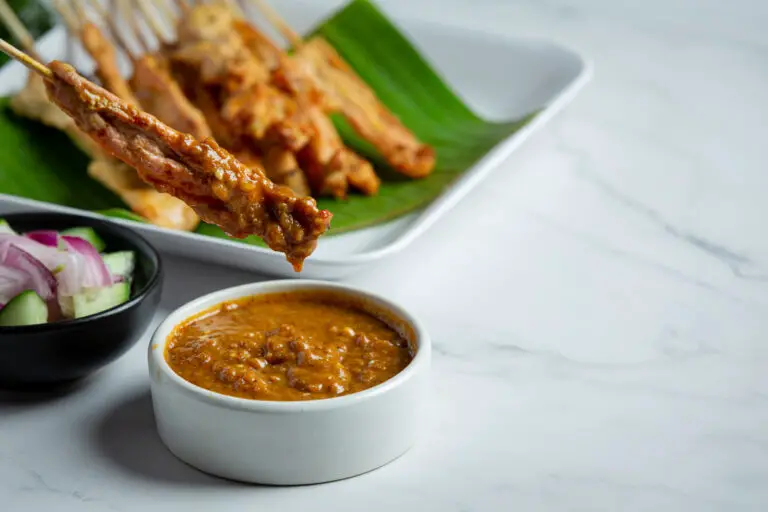Thai Kitchen Peanut Satay Sauce is a rich and flavorful sauce that has become a staple in Thai cuisine. It’s a perfect blend of creamy peanut butter, tangy tamarind, fresh garlic, and aromatic spices. This sauce is often used as a dipping sauce for grilled meats or as a flavorful addition to stir-fries and noodles.

Prep Time:
10 mins
Cook Time:
10-15 mins
Total Time:
25 mins
Servings:
6-8
Thai Kitchen Peanut Satay Sauce: A Historical Perspective
Origins of Satay Sauce
The roots of satay sauce can be traced back to Indonesia, but it has become a staple in Thai cuisine. The fusion of flavors and the unique blend of ingredients make it a favorite among chefs and food lovers alike.
Influence in Thai Cuisine
Thai Kitchen Peanut Satay Sauce has played a significant role in shaping Thai culinary traditions. Its versatility and rich flavor profile have made it a key component in various dishes.
Cultural Significance
The sauce is not just a culinary delight; it’s a symbol of Thai culture and hospitality. It represents the harmony of flavors and the balance that is central to Thai philosophy.
What is Thai satay sauce made of?
Essential Ingredients:
- Peanuts: The heart and soul of the sauce.
- Coconut Milk: Adds creaminess and depth.
- Soy Sauce & Fish Sauce: For that umami kick.
- Spices: A blend of coriander, cumin, and other spices.
Homemade vs. Store-Bought Thai Kitchen Peanut Satay Sauce
When it comes to Thai Satay Sauce, you have two primary options: making it at home or purchasing a store-bought version. Both options have their unique characteristics, benefits, and drawbacks. Let’s explore them in detail:
Homemade Thai Kitchen Peanut Satay Sauce
Advantages
- Customization: Making Thai Kitchen Peanut Satay Sauce at home allows you to tailor the flavors to your liking. You can adjust the spiciness, sweetness, and saltiness to suit your palate.
- Freshness: Homemade sauce guarantees fresh ingredients, enhancing the overall flavor and texture.
- Dietary Considerations: If you have specific dietary needs or preferences, such as vegan or gluten-free, you can control the ingredients to meet those requirements.
- No Preservatives or Additives: Homemade sauce doesn’t contain artificial preservatives or additives, often found in commercial products.
Disadvantages
- Time-Consuming: Making the sauce at home requires time and effort, from sourcing the ingredients to cooking and blending them.
- Skill Level: Achieving the perfect balance of flavors might require some culinary skill and experience.
Store-Bought Thai Kitchen Peanut Satay Sauce
Advantages
- Convenience: Purchasing a ready-made sauce is quick and easy, ideal for those with a busy lifestyle or who need a last-minute solution.
- Consistent Flavor: Store-bought sauces are manufactured to have a consistent flavor, ensuring that you know exactly what you’re getting every time.
- Availability: You can find Thai Kitchen Peanut Satay Sauce in many grocery stores, specialty shops, or online, making it accessible to most people.
Disadvantages
- Limited Customization: With store-bought sauce, you’re limited to the flavors and ingredients chosen by the manufacturer.
- Preservatives and Additives: Commercial sauces may contain preservatives and additives to extend shelf life, which some consumers may wish to avoid.
- Potential Allergens: Store-bought sauces might contain allergens or ingredients that don’t align with specific dietary needs or preferences.
Ingredients and Preparation
Ingredients for Thai Kitchen Peanut Satay Sauce
- Peanut Butter: 1 cup creamy peanut butter forms the base of the sauce.
- Coconut Milk: 1/2 cup to add richness and depth.
- Soy Sauce: 2 tablespoons for a salty and umami flavor.
- Fresh Lime Juice: 2 tablespoons for a tangy kick.
- Brown Sugar: 2 tablespoons to balance the flavors.
- Garlic: 2 cloves, minced, for a touch of warmth.
- Red Chili Flakes: 1/2 teaspoon for a hint of heat.
- Coriander: 1/2 teaspoon ground, for an earthy note.
Preparation Method
Time needed: 25 minutes
- Combine Ingredients:
In a medium saucepan, whisk together the peanut butter, coconut milk, soy sauce, lime juice, brown sugar, garlic, red chili flakes, and coriander.
- Cook the Sauce:
Place the saucepan over medium heat and cook, stirring constantly, until the sauce is smooth and heated through.
- Adjust Seasoning:
Taste and adjust the seasoning as needed. If the sauce is too thick, you can thin it with a little water or additional coconut milk.
- Serve:
Serve warm with grilled chicken, beef, or tofu skewers, or use as a sauce for stir-fried noodles or vegetables.
Nutritional Benefits and Dietary Considerations
Thai Kitchen Peanut Satay Sauce is not only delicious but also packed with nutritional benefits. The peanuts provide healthy fats and protein, while the coconut milk adds a dose of healthy saturated fats. This sauce can be part of a balanced diet and is suitable for vegetarians and vegans.
Serving Suggestions and Pairings
Serving as a Dipping Sauce
Thai Kitchen Peanut Satay Sauce is renowned for its role as a dipping sauce. Here’s how you can serve it:
- With Skewers: Grilled chicken, beef, or shrimp skewers are classic companions. Place a small bowl of the sauce on the side for dipping.
- With Spring Rolls: Whether fresh or fried, spring rolls taste delightful when dipped in this sauce.
- With Crudites: For a healthier option, serve with a platter of fresh vegetables like carrots, cucumbers, and bell peppers.
Serving in Main Courses
This sauce isn’t limited to appetizers; it can be a star in main courses as well:
- In Stir-Fries: Mix the sauce with stir-fried vegetables, tofu, or noodles. Serve hot, garnished with fresh cilantro or crushed peanuts.
- With Rice Dishes: Drizzle over steamed jasmine rice and grilled meats for a flavorful main course.
- In Sandwiches and Wraps: Spread on bread or tortillas for a Thai-inspired sandwich or wrap.
Serving as a Salad Dressing
For a creative twist, use Thai Kitchen Peanut Satay Sauce as a salad dressing:
- With Mixed Greens: Toss with mixed greens, grilled chicken, and mandarin oranges for a refreshing salad.
- With Noodle Salads: Mix with cold noodles, fresh herbs, and vegetables for a satisfying cold noodle salad.
Serving Temperature and Presentation
- Temperature: This sauce can be served warm or at room temperature, depending on the dish.
- Presentation: Garnish with fresh herbs, lime wedges, or crushed peanuts for a visually appealing presentation.
Storing and Reheating
Store any leftover Thai Kitchen Peanut Satay Sauce in an airtight container in the refrigerator for up to a week. To reheat, simply place in a saucepan over low heat, stirring occasionally, until warmed through.
FAQs
No, Thai peanut sauce and satay are not the same. While Thai peanut sauce often complements satay as a dipping sauce, satay specifically refers to the skewered and grilled meat.
Using store-bought Thai peanut sauce is simple and convenient. You can pour it as a dipping sauce, use it as a marinade, or add it to various dishes to enhance flavor. Just open the bottle, and you’re ready to enjoy!
Peanut satay sauce serves various purposes in cooking. Primarily, people use it as a dipping sauce for grilled meats like chicken or beef satay. Additionally, it works well in stir-fries, salads, and noodle dishes.
Thai satay sauce offers a rich and complex flavor. It combines the creaminess of peanuts with sweetness, saltiness, and a hint of spice. Together, these flavors create a harmonious blend that’s both savory and sweet.
The spiciness of satay sauce can vary. Some versions are mild, while others have a noticeable kick. If you prefer a specific level of heat, you can often adjust the spiciness to suit your taste buds.
Conclusion
Thai Kitchen Peanut Satay Sauce is a culinary delight that brings the authentic flavors of Thai cuisine to your kitchen. Its rich and creamy texture, combined with the perfect balance of sweet, salty, and spicy flavors, makes it a must-try for any food enthusiast. Whether you’re using it as a dipping sauce, a stir-fry addition, or a unique salad dressing, this sauce is sure to elevate your culinary creations.



